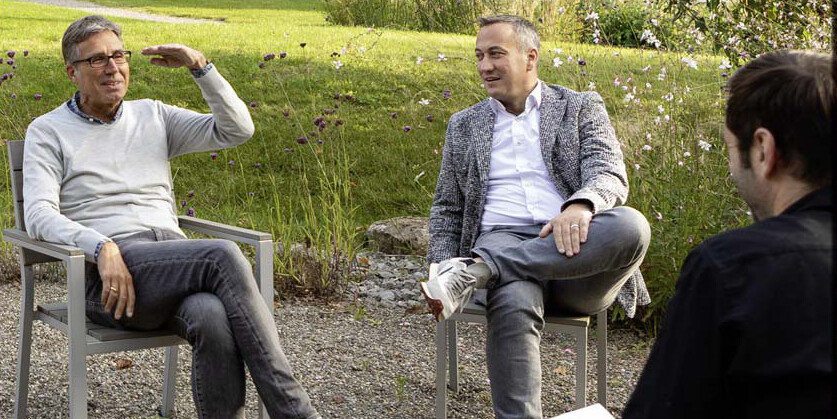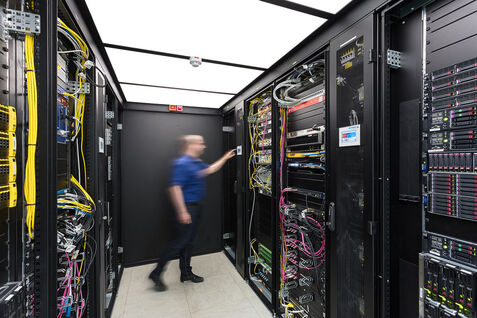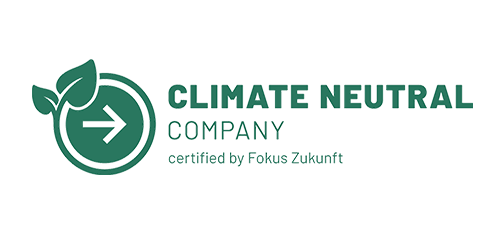
“We want to become sustainability multipliers.”
AEB is climate neutral. Managing Director Matthias Kiess and Board of Directors member Steffen Frey talk about how this was achieved and the company’s ongoing plans for sustainability.

AEB is climate neutral. Managing Director Matthias Kiess and Board of Directors member Steffen Frey talk about how this was achieved and the company’s ongoing plans for sustainability.
Steffen Frey: Respect for the climate and environment has long been part of AEB and is deeply encoded in our DNA. That can be seen in many areas and in many things the company does. With our actions, we want to play an active role in helping to achieve the 1.5°C target of the Paris Climate Accords. Becoming climate neutral is the logical next step in this effort and completely in character for AEB.
Matthias Kiess: And we’re just starting to really ramp up our activities. This year we measured our carbon footprint for the first time, giving us a foundation to accurately assess and guide our efforts. Now we know exactly where we have the most leverage for continued improvement going forward. And it’s important to acknowledge, of course, that we achieved climate neutrality this year in part through offsets, by investing in climate-friendly projects.
Steffen Frey: Now is when the real work begins. We can’t just say we’ll pay offsets and then check that box. We need to be just as systematic in avoiding and reducing emissions going forward. This takes an effort, generates no revenue, and becomes increasingly difficult the better we get. But it’s the only way for us to really achieve sustainable operations.
Matthias Kiess: Our carbon footprint shows very clearly that the greatest source of emissions is mobility: our fleet of cars, our trips to work, and our business trips. The second big block is what we eat, especially meat and milk products. What we need to do now is take a close look at this, come up with some ideas, study them, and put the most promising ones into practice.
Steffen Frey: We had already initiated several programs on both fronts. In the cafeteria at our corporate headquarters, for example, we have been using less meat for some time now and focusing more on creative solutions – and where we do use meat, we source it directly from the farm. With our company cars, we’ve had a car policy for ten years now designed to reduce emissions from our vehicle fleet. We also subsidize the use of public transit.
Matthias Kiess: But we need to do even more and think beyond this. Why not make public transit more attractive by counting the extra time spent commuting to the office as work hours? Or why not provide a pool of cars rather than giving specific employees their own dedicated company car?

Steffen Frey: We are working on building features into our software that let companies make their logistics more sustainable. I can still remember our first attempt three years ago, however. We had developed an MVP that could calculate and optimize not only the costs of transport logistics but also the carbon footprint. Unfortunately, the feedback we got from meetings with customers at the time was unanimous: “I can’t get any project or resources for this kind of thing approved in my company.” But we kept working on the idea anyway. Our Swedish customers were the main driving force here. And I feel certain that the mood throughout the corporate world has since changed. We welcome anyone who wants to help us think about or work on this issue.
Matthias Kiess: We’re definitely also making a difference by offering climate-friendly cloud software and minimizing the carbon footprint of our data centers. We achieve this by having our own photovoltaic system that supplies power to both data centers during the day. Our remaining energy needs are covered 100% by green electricity. We use the resulting waste heat for heating, and we take sustainability into account when choosing hardware.
Steffen Frey: We mustn’t fall into the trap of seeing sustainability only in environmental terms. That’s very relevant, of course. But we also need to think beyond this and look at issues such as social justice – especially when it comes to income and wealth distribution. We have a responsibility here, both as people and as a company. That’s why we’ve identified three areas of sustainability where we want to focus AEB’s corporate social responsibility: fighting climate change, protecting endangered species, and working for social justice and equal opportunity. We want to have a sustainable impact in these fields and make this compatible with our economic development. Our shareholder model also plays a role here. As an employee-owned enterprise, we counteract the excesses of the speculative economy.
Matthias Kiess: At its core, of course, sustainability is about justice and the fair use of resources. But another key point for us at AEB is: How can we create sustainable relationships? How can we design stability into the things we do together, such as customer relationships? If relationships are designed to be sustainable, it’s also much easier to overcome crises together. The same applies within the company and to the collaboration with our partners. And there are certainly many other aspects that we are not yet focused on today.
Steffen Frey: The AEB-Stiftung supports projects to help disadvantaged persons gain easy access to education. We’re helping to build more schools in socially vulnerable areas of Uganda and Brazil, for example, and are involved with Kinderhelden in Germany, which provides mentoring to disadvantaged children. Simply giving money is not enough, though. That’s why our support goes beyond just financial assistance to include a great deal of personal commitment and professional expertise on the part of AEB employees. That’s a good thing, of course. But navigating the right project with the right people around all the obstacles is work – lots of work. This work takes conviction and a lot of heart and soul. If we can manage to have even more employees lean in and give these efforts even more momentum, that would be wonderful.
Matthias Kiess: I’m proud that we launched the foundation – and of what it is achieving. But we actually need to think bigger. It’s not about just having a foundation, after all. It’s about having us as a company, with all our employees, embodying our corporate social responsibility. That’s why we want the commitment to be bigger, broader, and more diverse. We’re talking about different approaches for achieving this, such as whether we need to give every individual more flexibility. Why don’t we say that everybody at AEB gets a certain amount of special leave each year for civic engagement without having to provide proof?
Steffen Frey: Without a doubt, the willingness of the employees to get involved on this issue. A lot of people have stepped up to move it forward. We don’t need to convince them or twist any arms. The issue of sustainability is already deeply embedded in the company.
Matthias Kiess: That was my first thought as well. When we said we wanted to become climate neutral, it resonated immediately with a lot of people who said it was just their thing and they wanted to be actively involved. We simply have great people on board.
Steffen Frey: Even though we’re starting from such a solid and broad-based position, it’s important to me that our philosophy take root throughout the company. We want all our employees to internalize sustainability so that the environmental, social, and financial considerations play into all decisions, both big and small. It has to be built into the system. And people should encourage others to do the same.
Matthias Kiess: I don’t think vision is the right word at this point – it sounds so far off. Sustainability can’t be something distant that we have to move toward, it has to happen now. The most important thing is that we act as multipliers. We’re just one company, we only have a small gear to turn. And turn it we must, no question. But it’s essential that we interlock our gear with other gears to have a bigger impact. That’s why it’s my goal for us to be sustainability multipliers.
Matthias Kiess: One option would be to start a sustainability or climate club so that people and companies can join forces to work on sustainability. Some of our colleagues are already involved in such networks. Another specific example is the goods and magazines that postal and parcel services deliver. We need to ask the sender: Have you considered the emissions caused by shipping? Have you offset the production and shipping? If not, please tell me what offset we as recipients need to pay. And let’s look at what alternatives are available. If we sensitize others to the issue and work together on solutions, we can make a big difference.
Steffen Frey: I’ll come back to the point that we need to internalize these activities so we can also have fun while doing good. This then inspires others to join, both in their professional and personal lives. The result can easily and effortlessly generate a tremendous impact.

“If you can’t measure it, you can’t measure it”: The old management consulting truism is just as apt when it comes to climate action. Because only when businesses and organizations know the scope of their emissions can they take steps to cut back and offset the emissions they cause.
AEB began in 2021 by running an initial assessment of the greenhouse gas emissions caused by its business operations. The data collected was for 2019, the year before the coronavirus pandemic. At the time, things were still largely “normal” at AEB when it came to greenhouse gas emissions. The amount of business travel and the use of company offices and company cars were at a much higher level than in 2020 or 2021.
The measurements included not only CO2 emissions but also emissions of the six other greenhouse gases cited in the Kyoto Protocol, which were converted into CO2 equivalents. Based on the carbon footprint this yielded, AEB decided to invest in a climate project to offset its greenhouse gas emissions. This reforestation project is located in western Uganda and covers an area of 10,000 hectares, offsetting the equivalent of some 18,000 metric tons of CO2 emissions annually.
The project also helps advance other UN Sustainable Development Goals (SDGs), such as quality education, clean water, and decent work. It has received Gold Standard certification from TÜV Süd. Besides its climate neutrality project in Uganda, AEB supports local climate projects in order to have an impact in its own neighborhood. As outlined in the interview, however, the main goal is to identify, initiate, and implement measures that reduce and avoid emissions based on AEB’s carbon footprint.